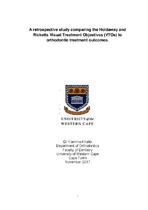| dc.contributor.advisor | Shaikh, A. | |
| dc.contributor.author | Khatib, Yoemna | |
| dc.date.accessioned | 2018-03-15T13:10:54Z | |
| dc.date.available | 2018-03-15T13:10:54Z | |
| dc.date.issued | 2017 | |
| dc.identifier.uri | http://hdl.handle.net/11394/5791 | |
| dc.description | Magister Chirurgiae Dentium - MChD (Orthodontics) | en_US |
| dc.description.abstract | Traditionally orthodontic treatment planning was predominantly based on
the dental occlusion without too much emphasis on and consideration for
facial proportions and aesthetics. Predicting treatment outcomes has
always been part of science. The ability to predict is important in other
areas of science and medicine, and it is important in the treatment of
orthodontic patients.
Holdaway coined the term "visualized treatment objective" (VTO), to
describe his predicted treatment outcome. Ricketts stated that all
treatment planning constituted some sort of prediction. His prediction
analysis allowed for forecast of the soft tissue profile which was based on
the reactions of the skeletal and dental components due to orthodontic
treatment.
The aim of this study was to compare the predicted outcomes of two
popular VTO's, viz Ricketts and Holdaway, to the actual outcomes of adult
patients. The complete Holdaway VTO and Ricketts VTO were done on
each pre-treatment cephalogram using the space analysis values from the
records. These VTOs predicted where the soft tissue profile (nose tip to
chin) would be, in relation to the H-line and E-plane respectively. The posttreatment
tracings were done. The two tracings for each patient were then
superimposed. | |
| dc.language.iso | en | en_US |
| dc.publisher | The University of the Western Cape | en_US |
| dc.title | A retrospective study comparing the Holdaway and Ricketts Visual Treatment Objectives (VTOs) to orthodontic treatment outcomes | en_US |
| dc.rights.holder | The University of the Western Cape | en_US |

